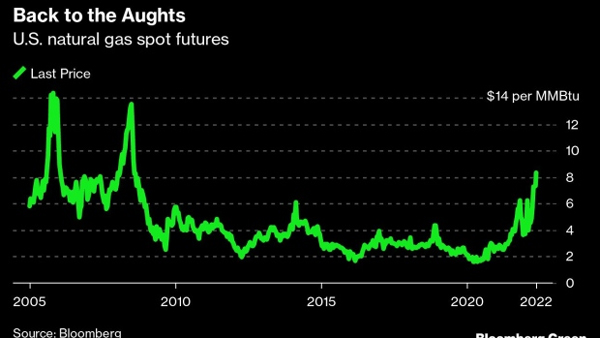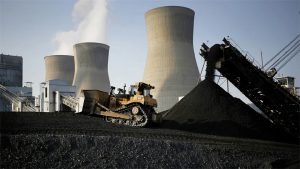
Nathaniel Bullard, Bloomberg News
WASHINGTON
EnergiesNet. 05 20 2022
A little more than a year after a paralyzing winter freeze, the Texas power market just experienced the stress of extreme heat. Last week, power prices in Houston briefly jumped above $5,000 per megawatt-hour as high temperatures coincided with a number of generators being offline for maintenance.
Yet a few days earlier, power prices in west Texas had been negative $883 dollars per megawatt-hour, because at the time wind generation was abundant and demand was low.
“Dynamic” is one way to describe the price swings within the Electric Reliability Council of Texas (Ercot), the grid that provides the majority of the state’s power. “Jarring” or “terrifying” might be other words for it, particularly for those buying power in the spot market.
In one respect — high gas prices — Texas’s current power system is a throwback to the aughts. Natural gas prices have increased fourfold since 2020 and are back to the same level they were at in 2008. The gas prices of 2005 to 2008 forced grid operators, regulators and long-term planners in Texas and elsewhere to carefully consider the future power mixes in their markets.
Gas prices may be back to the levels of 14 years ago, but power markets, and the Texas market in particular, are very different indeed. The state’s coal fleet has shrunk; its nuclear fleet has not grown; the number of bigger combined-cycle gas power plants has expanded, while smaller open-cycle and reciprocating-engine gas plants have dwindled significantly.
Then there are renewables. Over the past decade, installed wind capacity in Texas has nearly tripled. Solar capacity has expanded more than 260 times and battery capacity has increased by a factor of almost 800. All of these technologies are expected to keep growing, too, just in the next two years. By the end of 2023, installed wind capacity could increase another 40% from 2021, with solar tripling and batteries growing seven-fold.
I am not an energy modeler, so I won’t pretend to construct a long-term forecast for the next decade. I can, however, highlight some possibilities for the future of the Texas grid. I do not imagine that any one will happen wholly to the exclusion of the other; rather, I expect them to act in concert and impact each other in possibly significant ways.
One possibility: Higher prices are here to stay. That includes natural gas prices, which would encourage fuel-switching at the grid level between gas- and coal-fired power and would likely discourage the construction of new gas-fired power plants. Developers of new power generation may look at today’s current prices and be more confident in the economics of wind and solar … but of course, prices for wind and solar equipment are also increasing, because of commodity costs, snarled supply chains, trade cases and labor costs. High prices across the board, in a situation where many technologies compete on the margin, is paradoxically quite uncertain for companies planning many years out.
Another possibility is that infrastructure arrives in force. The bipartisan law passed in November has tens of billions of dollars for transmission, which would encourage the building of more wind and solar in resource-rich areas and send more power to urban and suburban demand centers. It would also flatten out—or eliminate—situations in which prices in one part of the state are punishingly high, while at the same moment, renewable projects in distant areas are actually penalized for their power output.
Yet another possibility is that the nature of electricity demand in Texas changes significantly, with consumers opting out of the grid where they can. Buyers of electricity both big and small may decide that the best defense against an uncertain future for the state’s electricity sector is to take control of it for themselves. Many technology companies already meet 100% of their electricity demand from renewables, but smaller companies may decide to generate their own power and store it, lessening their draw on the grid.
At the same time, power demand could also grow significantly thanks to electric vehicle charging, more use of air conditioning (due to both the changing climate and population growth) and cryptocurrency mining. Ercot has already forecast that by mid-2023, crypto mining will increase demand on the grid by as much as the power needed for all the homes in Houston. Electrification of industrial processes that currently consume fossil fuels could also cause demand to go up substantially, and production of “green” hydrogen using renewably powered electrolyzers could drive it up even more.
The final possibility is the most intriguing: We don’t really know what the prime movers of supply and demand in the 2030s will be. I promise this is not just an analyst’s cop-out. Even the most thoughtful, thoroughly modeled analysis of the 2021 Texas power system from 15 years earlier would not have imagined solar prices where they are today, the prevalence of batteries, energy demand from data centers, crypto mining or a coming wave of millions of electric vehicles. Some of those factors would have required outlandishly aggressive assumptions to predict today; others simply did not yet exist.
For those planning the future, the call to action is two-fold. First, be extremely focused on economics and projections of those things you can know about today. Second, be as imaginative as you can in considering future supply and demand. The future will lie somewhere in between.
bloomberg.com 05 19 2022







